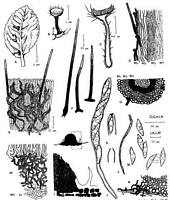|
 Torrendiella andina Torrendiella andina
BiostatusAbsent from region
Images (click to enlarge)
Caption: Fig. 1. Torrendiella andina (BCRUI187). A, Nothofagus dombeyi leaf with apothecia; B, apothecium;
C, longitudinal section of an apothecium; D, longitudinal section of the stipe; 
Caption: Fig. 2 Torrendiella andina (A-C, D-E, H, PDD 69807; F-G, PDD 69808). A, apothecium in
vertical section; B, side of receptacle in vertical section; C, detail of B, showing inner | |
Article: Johnston, P.R.; Gamundí, I.J. (2000). Torrendiella (Ascomycota, Helotiales) on Nothofagus. New Zealand Journal of Botany 38(3): 493-513 (http://www.rsnz.org/publish/abstracts.php).
Description: Apothecia developing on fallen leaves, growing on both sides and margin of
leaves, leaves darkened but not showing definite stromatised areas; erumpent through host
cuticle, arising from small, dark stroma; apothecia 0.6-2 mm diam., stipitate, fleshy; disc
plane or convex, grey-yellowish ("avellaneus" to "sepia"); receptacle dark brown, receptacle
and margin with fuligineous setae; stipe 0.5-1 x 0.18-0.27 mm, cylindrical, base bulbous,
blackish. Paraphyses 1.5-2 µm diam., slightly swollen near apex. Asci 117-147 x 9-11 µm,
cylindric-clavate, tapering to base, wall thickened at apex, with strongly amyloid pore, 8-spored. Ascospores 16-17.5 x 3.8-5.8 µm, fusoid, asymmetrical, containing 1-4 guttules,
hyaline to slightly yellowish; 1-2-seriate. Ectal excipulum 3-layered; outer layer one cell
wide, forming a radial network over receptacle, more or less parallel on stipe, comprising
hyphae 2.5-5.5 µm diam. with walls brown, thickly encrusted; central layer 18-25 µm thick,
comprising textura porrecta of hyphae 2.5-4.5 µm diam. with walls hyaline, gelatinous; inner
layer 18-23 µm thick, comprising textura porrecta of hyphae 2.5-4.5 µm diam. with walls
pale brown, irregularly encrusted, nongelatinous. Medullary excipulum comprising textura
intricata of hyphae 2.5-4.5 µm diam. with walls hyaline, nongelatinous. Setae arising from
the central layer of ectal excipulum on receptacle, from outer layer of ectal excipulum on
stipe, 150-520 x 5.8-11 µm, swollen near the base, tapering to base, base simple on
receptacle, L- or T-shaped on stipe, wall smooth, dark brown, opaque, often paler near
subacute apex, pluriseptate.
APPEARANCE IN CULTURE: OA: 18-80 mm diam.; aerial mycelium cottony, forming patchy
tufts, white to grey; agar surface orange-brown to red-brown; in reverse with patches of
orange brown pigmentation. PDA: 30-35 mm diam.; margin uneven, surface of colony raised
and deeply convoluted; aerial mycelium low, felted to cottony, tufted, variable in
pigmentation, white, pale grey, bright yellow, or pinkish; in reverse very dark orange-brown;
deep yellow pigment diffusing into agar across plate. MEA-M: 20 mm diam.; aerial
mycelium sparse, whitish; surface of agar deep orange-brown; orange-brown pigments
diffusing into agar across plate (BCRU 1850 with less well developed pigment, faster growth,
and quite dense tufted to felted mycelium with irregular patches of white, pale grey, and
bright yellow pigments). MEA-D: similar to MEA-M (BCRU 1847 with faster growth, thin
colonies with little aerial mycelium and irregular patches of purplish-grey pigment).
Notes: ETYMOLOGY: the specific epithet refers to the southern South American distribution of this
species, along the Andes.
T. andina is the most common Torrendiella species in the Andean-Patagonian forest
of South America. It is characterised by the subcuticular stroma from which the apothecia
arise, the long stipe, and very dark receptacle. The dark appearance is due to the well
developed outer excipular layer. This layer, continuous and one cell thick in the stipe, forms a
brown net over the receptacle. Small, immature apothecia are darker than those that are
mature, and it is possible that as the hymenium expands with maturity, the outer excipular
layer becomes disrupted and the hyphae become separated, so forming the characteristic net.
Although T. andina is found on more than one host species, it is interesting to note
that N. betuloides and N. dombeyi are closely related, and are both evergreen with similar,
coriaceous leaves. N. dombeyi grows in northern Patagonia on the eastern slopes of the
Andes from about 38o 40' S to 43o 40' S and is a montane species; N. betuloides reaches sea
level in Tierra del Fuego, growing from about 48° S to 56° S.
Note that the collections BAFC 20345 and 20304 were recorded erroneously by
Gamundí (1962) as Zoellneria eucalypti.
|